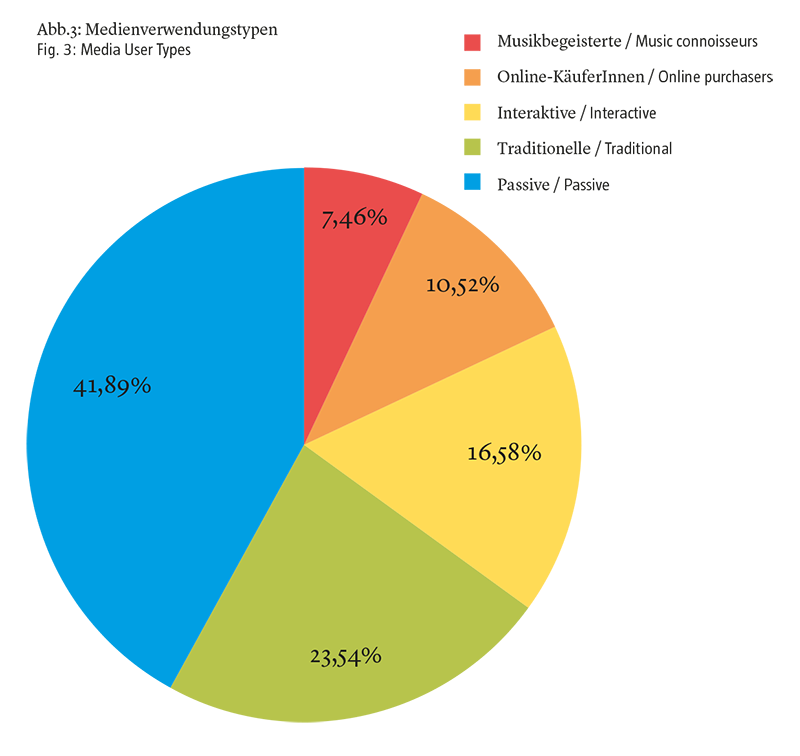In the space of just a few years, the Internet and mobile telephony have changed our daily lives to a greater extent than almost any previous technical innovation. Since the 1990s, our ability to access and disseminate information has expanded massively; however, we are virtually incapable of controlling these flows of information. When converted into binary code, sounds can be carried by data networks and stored so as to be accessible to anyone. This has resulted in a surplus of ways in which we can access and listen to music. The Department of Music Sociology at the University of Music and Performing Arts Vienna has a long tradition in research into how developments in media influence our consumption of music (Bontinck 1974, Blaukopf 1989, Smudits 2002). A new volume, number 36 in the department’s own Music and Society book series, now presents the results of research into how the digital media revolution has changed the way people in Austria access and use music. The absence of any comparable complex and theory-based empirical research at an international level means that the findings presented here are of particular significance, and are relevant beyond a national perspective.

The premise for the research was based on the observation that, while in the twentieth century youth culture was closely bound up with music (which was in turn of great importance within society), all this has now largely changed. We can still see differences in the behaviour of younger and older music listeners, but these differences are now less marked in the characteristics of the music itself; rather, the generations tend to differ far more as regards their attitude to music in general, how they evaluate it and how they use it. These days, social media such as Facebook, WhatsApp and Musically allow us to see and be seen, to comment and to be commented upon. This appears to have led to “digital natives” (Prensky 2001) treating music not so much as a core interest in itself, but rather as a trigger for communication and (self-) presentation. A principal theme of the research was thus to explore the extent to which such observations can be generalised by surveying representative samples, and whether the trend throws up social variations.
On the basis of key music sociology theories on the themes of social differences in how music is accessed and experienced, a comprehensive questionnaire was drafted and worked through in 1.199 face-to-face interviews of 20 minutes each. Interviewees were selected so as to represent the general population of Austria over the age of 16 with regard to age, gender, education, income, country of origin, and the size of their town of residence. Responses were centrally processed and interpreted using statistical methods such as correspondence- and cluster analysis. In this summary there is only space to present a small selection of the findings; for complete coverage, including the theoretical bases for the research, see the abovementioned book (Huber 2018). A notable characteristic of these findings is their comparison of music behaviour between different “media generations”. People born after 1990 grew up with the Internet and mobile phones. Their musical socialisation reflects the fact that an overabundance of music is freely available on the Internet. In the way they listen to music and the music they listen to, they differ – sometimes greatly – from those listeners who were socialised in the analogue era, with its control over sales and the target group orientation of the music media industry.

Let it be said at the start that in all the differences between the generations, we can also observe ways of using music that are scarcely different, or statistically insignificant. For example, young people in general attend concerts no more frequently than older people, and they are no more likely to listen to music “incidentally”. The generations’ willingness to spend money on music also differs little: young people spend only fractionally more money on downloads, streaming, music events and physical music media.

However, we can observe great differences in how often people listen to various styles of music. For example, young people listen to techno, house and hip-hop far more frequently than the over-25s; folk and “Schlager” music, though, far less. Interestingly, although older people far more often expressed a preference for classical music, they actually listened to it scarcely more frequently than the young. Also of note is the fact that members of “Generation Web 2.0” stand out as more conscious of the ways they can use music in their daily lives, and what effect that music has. For example, they use music far more intensively to set the mood, as a background to parties and get-togethers, as a topic of conversation, or as a reminder of experiences and people. Similarly, whereas around half of over-25s say they very much enjoy listening to music when out and about (in the car, on the train or bus etc.), fully three quarters of young people say they like to do this. An even greater difference is observed in how younger people listen to music during sport, when going out for the evening, or with friends. The importance they attach to music is not least reflected in the fact that – compared to the over-25s – more than twice as many of them play music and/or sing together more than once a week. These differences are hardly surprising, and can only be partly ascribed to digitalisation.
What can, however, be ascribed to digitalisation is the musical behaviour that differs most of all between today’s young people and older generations: the use of the Internet and smartphones. The most significant group segment variations in the entire study can be seen in how the generations that were socialised in the analogue and digital eras differ in the way they use the Internet for music (figure 1). While older people more often access music via the radio (followed by TV and CD), among young people the smartphone has progressed from last place to first place in the space of only five years (2010–2015). The immense significance of the Internet as a key differentiator between the generations can also be seen in the importance young people attach to it for their own musical socialisation; as can be seen in figure 2, this difference is disproportionately large.
In general, in the way they use music, the people of Austria tend to be split into young/old, urban/rural, more/less educated, and above all online/offline. As regards use of media, five music reception types may be identified, which differ clearly as to their attitudes and behaviours (figure 3). The digital media revolution has further reinforced existing differences, giving rise to an urgent need for action on the part of music educators. Education’s duty to cause music to be perceived as personally fulfilling and socially enriching has not changed; a new challenge of the Web 2.0 era is to impart an approach to music that allows the individual to autonomously and confidently benefit from the vast array of music on the Internet.
Blaukopf, Kurt. 1989. Beethovens Erben in der Mediamorphose. Kultur- und Medienpolitik für die elektronische Ära. Heiden: Niggli.
Bontinck, Irmgard (Ed.). 1974. New Patterns of Musical Behaviour. A Survey of Youth Activities in 18 countries. Vienna: UE 1974
Huber, Michael. 2018. Musikhören im Zeitalter Web 2.0 – Theoretische Grundlagen und empirische Befunde. Wiesbaden: Springer VS.
Prensky, Marc. 2001. Digital Natives, Digital Immigrants, Part 1. On the Horizon 9 (5): 1-6.
Smudits, Alfred. 2002. Mediamorphosen des Kulturschaffens. Kunst und Kommunikationstechnologien im Wandel. Vienna: Braumüller.

